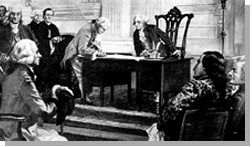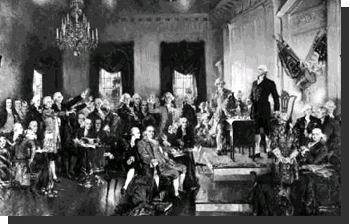![]()

![]() Wanna
know the consequence of the revolution? Here is your chance!
Wanna
know the consequence of the revolution? Here is your chance!
![]()
![]()
![]()
![]()

Signing
the Constitution
The Constitution of the United States comprises the nation's fundamental law, providing the framework for its governance and the principles under which it must operate. Judicial reinterpretation has given the Constitution the flexibility to accommodate changes in the specific laws subject to its authority. As Chief Justice John Marshall pointed out early in the 19th century, the Constitution was "intended to endure for ages to come, and, consequently, to be adapted to the various crises of human affairs. To have prescribed the means by which government should, in all future times, execute its powers, would have been to change entirely, the character of the instrument, and give it the properties of a legal code."
The distinction Marshall made between the Constitution and other law was in keeping with the framers' provision for the supremacy of the Constitution in Article VI, which states: "This Constitution, and the Laws of the United States which shall be made in pursuance thereof; and all Treaties made, or which shall be made, under the Authority of the United States, shall be the supreme Law of the Land . . . ."

Constitutional Convention |
The first constitution of the United States was the Articles of Confederation ratified in 1781. Because this document left too much sovereignty to the states, it was defective as an instrument of government. Some leaders felt that the individual states suffered economically from the lack of a strong central authority; commercial barriers between the states seemed particularly onerous. They also felt that the lack of unity among the states was causing serious problems in international relations and defense. The weakness of the central government was dramatized by such events as Shay's Rebellion (1786-87) in western Massachusetts, and by the ability of one state to block legislation desired by the other twelve. The Annapolis Convention of 1786 called for a general Constitutional Convention that met at Philadelphia in May 1787.
|
![]()
![]() Let's
have a brief conclution about this revolution. Have a look at the
Timeline...
Let's
have a brief conclution about this revolution. Have a look at the
Timeline...![]()